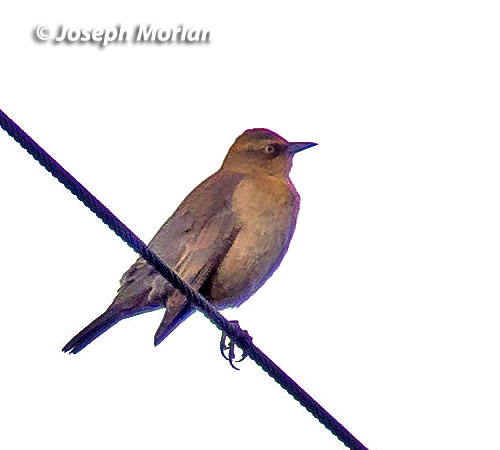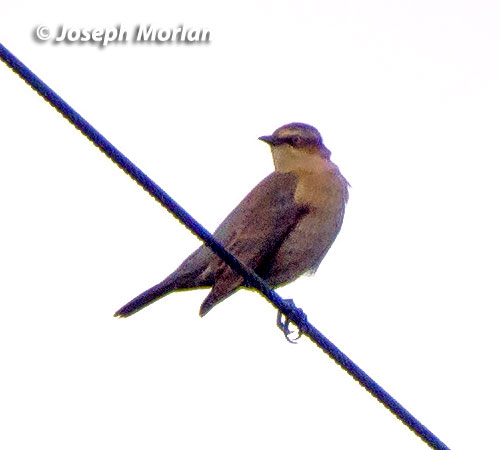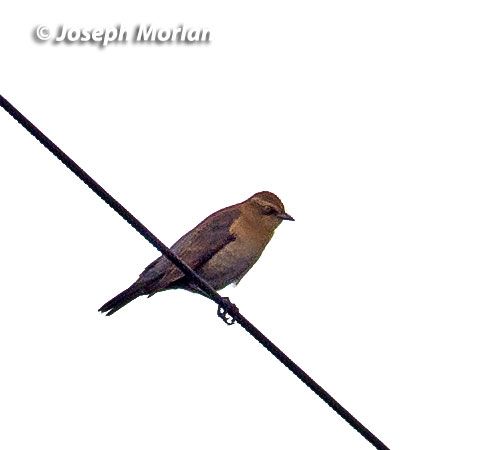Rusty Blackbird (Euphagus carolinus carolinus)
Gustine, Merced County, CA
21 November 2014
Joseph Morlan
Photos © 21 November 2014 by Joseph Morlan. All rights reserved. Click
here for higher resolution images.
 This
bird was found and photographed by Susan Murphy and Joanne Katanic on 13 November. I was attending the Central
Valley Birding Symposium Conference in Stockton and took Friday morning, 21 November to bird Santa Fe Grade Road
from Los Banos to Gustine. I arrived at the Gustine site, just north of Gun Club Road about 11am where another
birder was looking for the Rusty Blackbird. After considerable searching, the bird finally appeared on an overhead
wire and I was able to obtain the photos seen here and show the bird to the other birder. The Rusty Blackbird then
dropped into the shallow water near the edge of the road just north of the 5th pole and foraged behind dense vegetation.
From this position it was not possible to photograph the bird. Eventually a nearby flock of Red-winged Blackbirds
flushed the Rusty Blackbird and that was that. I headed back to the conference in Stockton.
This
bird was found and photographed by Susan Murphy and Joanne Katanic on 13 November. I was attending the Central
Valley Birding Symposium Conference in Stockton and took Friday morning, 21 November to bird Santa Fe Grade Road
from Los Banos to Gustine. I arrived at the Gustine site, just north of Gun Club Road about 11am where another
birder was looking for the Rusty Blackbird. After considerable searching, the bird finally appeared on an overhead
wire and I was able to obtain the photos seen here and show the bird to the other birder. The Rusty Blackbird then
dropped into the shallow water near the edge of the road just north of the 5th pole and foraged behind dense vegetation.
From this position it was not possible to photograph the bird. Eventually a nearby flock of Red-winged Blackbirds
flushed the Rusty Blackbird and that was that. I headed back to the conference in Stockton.
Description
The following description is based on memory and on photos:
A medium sized icterid, similar in size and shape to a Brewer's Blackbird, but with a shorter tail, thinner
bill and different plumage. The back and underparts were washed with warm fulvous, becoming stronger across the
chest and throat. The crown was the brightest part of the bird, being a copper color. There was a modest supercilium,
rusty in color below the cap, and contrasting with a weak mask through the eye. The eye was not very light, but
appeared to be a dull pale brownish-yellow. Not dark, but not very light either. Tertials and coverts were well marked
with rusty fringes. Feet and legs dark. Rump, tail and lower back were dull gray.
coverts were well marked
with rusty fringes. Feet and legs dark. Rump, tail and lower back were dull gray.
Identification
Although this is a distinctive species, there have been several recent cases of variant
Brewer's Blackbirds that look similar to some Rusty Blackbirds; particularly they resemble adult Rusty Blackbirds
in the Spring. However, in the fall all Rusty Blackbirds should be more brightly colored particularly on the crown.
Discussion
This species was added to the CBRC review list in 2006 after it became clear that this species had undergone
a mysterious but serious 85-95% population decline in its core area in the Eastern United States.
Age, sex and subspecies.
This individual has gray wings and rump, and lacks black spotting on the underparts identifying it as a female.
Although females are not normally aged safely in Fall, I believe the honey colored iris suggests that this is a
young (HY) female. Juveniles have dark eyes becoming pale yellow in the first fall, and bright yellow in adults.
Two races are recognized. Birds seen in California are assigned to the widespread nominate subspecies. A slightly
darker race (E. c. nigrans) breeding in the Maritime Provinces is thought to winter in Georgia and the Carolinas.
External Links
Additional photos have been posted:
- 13 November
- 15 November
- 16 November
 This
bird was found and photographed by Susan Murphy and Joanne Katanic on 13 November. I was attending the Central
Valley Birding Symposium Conference in Stockton and took Friday morning, 21 November to bird Santa Fe Grade Road
from Los Banos to Gustine. I arrived at the Gustine site, just north of Gun Club Road about 11am where another
birder was looking for the Rusty Blackbird. After considerable searching, the bird finally appeared on an overhead
wire and I was able to obtain the photos seen here and show the bird to the other birder. The Rusty Blackbird then
dropped into the shallow water near the edge of the road just north of the 5th pole and foraged behind dense vegetation.
From this position it was not possible to photograph the bird. Eventually a nearby flock of Red-winged Blackbirds
flushed the Rusty Blackbird and that was that. I headed back to the conference in Stockton.
This
bird was found and photographed by Susan Murphy and Joanne Katanic on 13 November. I was attending the Central
Valley Birding Symposium Conference in Stockton and took Friday morning, 21 November to bird Santa Fe Grade Road
from Los Banos to Gustine. I arrived at the Gustine site, just north of Gun Club Road about 11am where another
birder was looking for the Rusty Blackbird. After considerable searching, the bird finally appeared on an overhead
wire and I was able to obtain the photos seen here and show the bird to the other birder. The Rusty Blackbird then
dropped into the shallow water near the edge of the road just north of the 5th pole and foraged behind dense vegetation.
From this position it was not possible to photograph the bird. Eventually a nearby flock of Red-winged Blackbirds
flushed the Rusty Blackbird and that was that. I headed back to the conference in Stockton.
 coverts were well marked
with rusty fringes. Feet and legs dark. Rump, tail and lower back were dull gray.
coverts were well marked
with rusty fringes. Feet and legs dark. Rump, tail and lower back were dull gray.